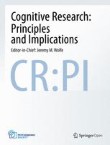Cognitive Research: Principles and Implications is affiliated with The Psychonomic Society
The impact of an intervention program on students’ spatial reasoning: student engagement through mathematics-enhanced learning activities
Spatial reasoning skill has consistently been found to be malleable. However, there is little research to date on embedding spatial training within learning frameworks. This study evaluated the effects of a cl...
